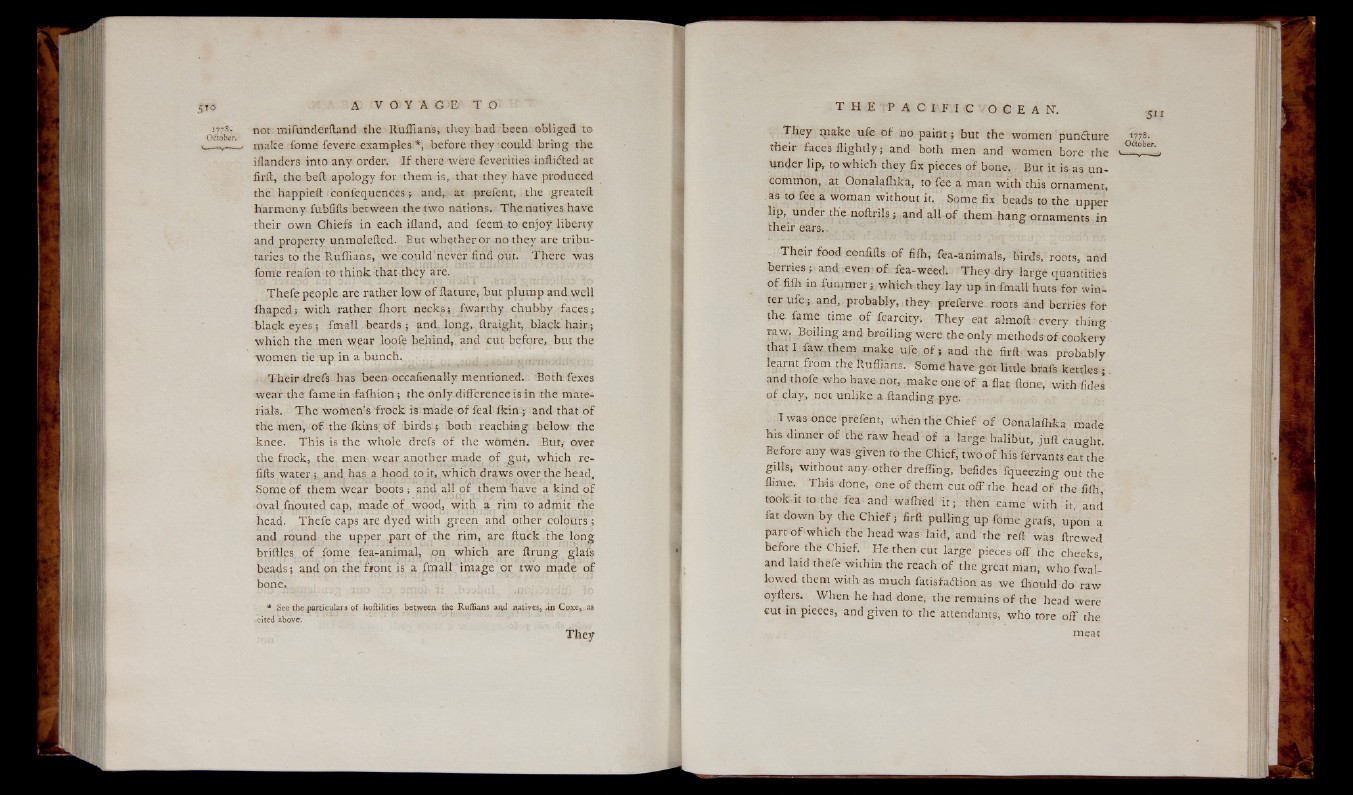
not mifunderftand the Ruffians, they had been obliged t®
make fome fevere examples *, before they could brin g the
iilanders into any order. I f there were feverities infiifted at
firft, the bell apology for them is„ithat they have produced
the happieft confequences; and, at prefent, the greateft
harmony fublifts between the two nations. ■ The natives have
their own Chiefs in each ifland, and feem to enjoy liberty
and property unmaiefted. But whether or no they are tributaries
to the Ruffians, we copld'never-find gut. The re was
Tome reafon to think that they a r e .. ", _
The fe people are rather low o f ilature, but plump and well
ihapedj w ith rather ihort n eck s; fwarthy chu bby fa c e s ;
black eyes ; fmall beards ; and. lo n g , liraight, bla ck h a ir ;
w h ich the men wear loofe behind, and cut before, but the
women tie up in a bunch.
- Their drefs has been occafionally mentioned. Both fexes
wear the fame in faihion ; the only d ifference is in the materials.
T h e women’s fro ck is made o f feal ikin ; and that o f
the men, o f the Ikin s; o f b ird s ; both reaching below the
knee. This is the whole drefs o f the women. But, over
the frock, the men wear another made. o f g u t, which refills
water-;,.and has a hood to it, which draws over the head.
Some o f them wear boots ; arid a ll o f them have a kind o f
-oval fnouted cap, made o f wood, with a rim toadm.it the
head. Thefe caps are dyed with green and other co lours;
and round the upper part o f the rim, are ftuck the long
brifties o f fame. fea-anira^i, qn which are lining, giafs
beads; and on the front is a fmall image o r two made o f
b o n e ,....
* See the particulars o f faoftilities between the Ruffians and n a tiv e s ,in C oy e v..ai
• cited above:
T h e y rnake ufe o f no p a in t ; but the women pundlure *778.
their faces fligh tly ; and both men and women bore the
under lip, to which they fix pieces o f bone. But it is as u n common,
at Oonalaihka, to fee a man with this ornament,
as to fee a woman without it. Some fix beads to the upper
lip, under the noftrils ; and a ll o f them han g ornaments in
their ears,. , ,
T h e ir food coafifls o f filh, fea-animals, birds, roots, and
berries ;{and even o f fea-weed. T h e y dry- large quantities
o f filh in fum m e r ; which they-lay u p in fm a ll huts for winter
u f e ; and, probably, they preferve. roots and berries fo f
the fame time o f fcarcity, T h e y eat almoft. every thing
raw. Boiling and broiling were th e o n ly methods o f cookery
that I Taw them make ufe o f ; and the firft was probably
learnt from the Ruffians. Some have got little brafs kettles ;
and thofe who have not, make one o f a-flat ftone, with fides
o f clay, not unlike a Handing pye.
Iwas once prefent, when the Chief o f Oonalaihka made
bis dinner o f the raw head o f a large halibut, juft caught.
Before any was given to the. Chief, two o f h is fervams eat the
gills; without any-other dreffing, befides Tqueezing out the
flame. This done, one o f them cut o ff the head o f the filh,
took it to the fea and walked it ; then came with it, and
fat down by the C h ie f ; firft pulling up Tome grafs, upon a
part o f which the head was laid, and the reft was llrewed
before the Chief. He then cut large pieces o f f the cheeks,
and laid thefe within the reach o f the great man, who fwal-
lowed them w ith as much fatisfailion as we flrould do raw
oyfters. When he had done, the remains o f the head were
cut in pieces, and given to the attendants, who tore o ff the
meat